4/15/2010
Perennials: Crossover Artists
John Friel
Is it wise to encourage annual growers to do perennials? Some perennial growers will answer with a resounding “No!” perhaps via notes tied to bricks hurled through my window. I hate that.
But really, how many true annuals-only and pure perennials-only growers are there? We’ve clearly seen a blurring of the lines between those who grow this and those who grow that. (Pardon the apparent oxymoron, but one really can see a blur clearly: Yep, that’s a blur.)
Tree and shrub nurseries find space for faster-turning perennials. Bedding pack growers incorporate hardier stuff for better margins and longer seasons. And perennial growers offer selected woodies and “temperennials.”
That’s natural. Good gardens blend all those ingredients. Drawing hard lines between categories is a human conceit. Wilderness is a happy riot of tough and tender, constant and ephemeral, all jockeying for position and competing for light, water and nutrients—just as we compete for available retail space and our favorite green nutrient, money.
So let’s get on with it: What makes a perennial a good fit for annual growers? Logically, they should act like annuals, i.e., predictably. Seed varieties should germinate well and crop uniformly. Cuttings of vegetatively produced varieties should be readily available and root at a high percentage.
If you’re about to plunge into the perennial pool, brace yourself: Most perennials simply do not sprout at 100%-plus like your impatiens and begonias. Many genera will give you 75% if you do absolutely everything right; others, much less. Relax—it’s not you.
Cuttings are safer, albeit costlier: the URC perennial pipeline is well established, and most growers tap it. Liners are safer yet. Whether you propagate your own or leave that step to specialists like my employer, here are some choice genera to consider.
CAMPANULA—Bellflower 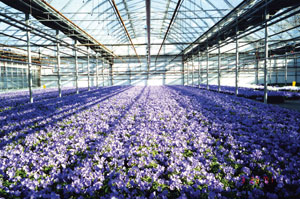 There are annual and perennial species, but probably the best hardy type for pot crops is C. carpatica, a.k.a. Carpathian harebell. Native to the Carpathian Mountains of Eastern Europe, the species is valued for its compact habit, attractive green foliage, and cheerful blooms in shades of blue and white. Several strains are available; best known are the very similar Clips and Uniform series, both about 8-in. tall. A more recent F1 hybrid is Pearl from Benary. Available in light blue, deep blue and white, this FloraStar winner promises shorter stature (6 in.) and up to two weeks earlier flowering.
There are annual and perennial species, but probably the best hardy type for pot crops is C. carpatica, a.k.a. Carpathian harebell. Native to the Carpathian Mountains of Eastern Europe, the species is valued for its compact habit, attractive green foliage, and cheerful blooms in shades of blue and white. Several strains are available; best known are the very similar Clips and Uniform series, both about 8-in. tall. A more recent F1 hybrid is Pearl from Benary. Available in light blue, deep blue and white, this FloraStar winner promises shorter stature (6 in.) and up to two weeks earlier flowering.
Advantages: An easy, predictable grower. Decent germination rates. A perfect dual-purpose plant, at home on the windowsill and in the border.
Drawbacks: Shorter flowering period than most annuals. Not self-cleaning.
CERATOSTIGMA—Plumbago, leadwort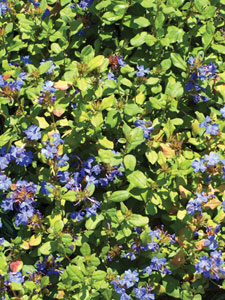
I recommend this one with some hesitation. In the garden, Ceratostigma plumbaginoides breaks very late. But try it as a hanging basket in a coir planter: Its stoloniferous habit sends shoots right through the fiber, creating a solid ball of color—and what color! The flowers are a startling, electric-periwinkle blue, and true blues are scarce in perennials. In fall, the foliage turns deep red, contrasting strikingly with the persistent flowers.
Advantages: Tough, easy and fast once it gets started. Cuttings are available. Startling blue flowers and good fall color. Great for overplanting with bulbs.
Drawbacks: Slow to emerge from dormancy. Can run (as good groundcovers should) in the garden.
COREOPSIS—Tickseed
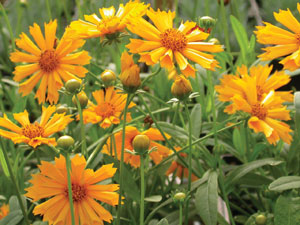 There are too many good Coreopsis varieties to count, from seed and from cuttings. Moonbeam has become such a staple, it’s known as a “gas station plant.” That sounds insulting, but it’s really a compliment: Gas station plants tolerate harsh conditions like ‘hell strips,” plantings hemmed in by pavement. Those pretty little islands of greenery too often become ghastly little desert islands of brownery in droughty summers.
There are too many good Coreopsis varieties to count, from seed and from cuttings. Moonbeam has become such a staple, it’s known as a “gas station plant.” That sounds insulting, but it’s really a compliment: Gas station plants tolerate harsh conditions like ‘hell strips,” plantings hemmed in by pavement. Those pretty little islands of greenery too often become ghastly little desert islands of brownery in droughty summers.
Early Sunrise was an AAS winner precisely because it acted like an annual, blooming reliably the first year from seed. More recently, Itsaul Plants produced the extraordinary Jethro Tull by breeding Early Sunrise with Zamphir.
Advantages: Easy, tough, versatile. Wide range of forms and sizes.
Drawbacks: Too many varieties to choose from. Watch for powdery mildew on Moonbeam and other thread-leaf types.
GAILLARDIA—Blanket flower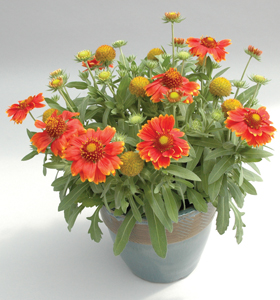
Like campanula, gaillardia offers tender and hardy species. Some interesting hybridizing is going on in America and Europe to bring together the best of both. Meanwhile, the Gallo series from Sahin via Aris are a good bet. The flowers are durable, and even after the petals drop the seed heads hold color and add interesting form. Arizona Sun, at just 8 in. to 12 in., is a natural. Georgia Sunset and Georgia Yellow are taller (15 in. to 18 in.), but flower from late spring right through to fall.
Advantages: Easy and durable. Uniform cropping. Long bloom season.
Drawbacks: Flower form is perhaps a bit too familiar to be accepted as annual color.
GAURA—Bee blossom, wand flower
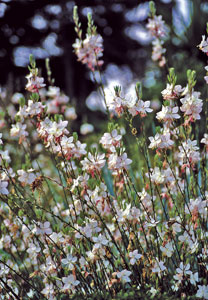 Older forms of this Texas native are too big, loose and blowsy for today’s size-obsessed market. Newer varieties are right up the annual grower’s alley—fast, compact and manageable. Which is great at retail: The four-petaled flowers with their distinctive long stamens dance in the slightest breeze. The cute pots beg to be picked up and taken home. Newer types also offer variations in form and color. Flowers come in white, pink, and deep pink. Foliage can be solid green, gold-variegated, rich red, or green with pink edging.
Older forms of this Texas native are too big, loose and blowsy for today’s size-obsessed market. Newer varieties are right up the annual grower’s alley—fast, compact and manageable. Which is great at retail: The four-petaled flowers with their distinctive long stamens dance in the slightest breeze. The cute pots beg to be picked up and taken home. Newer types also offer variations in form and color. Flowers come in white, pink, and deep pink. Foliage can be solid green, gold-variegated, rich red, or green with pink edging.
But I miss the see-through garden appeal of older, laxer forms, interlaced with rigid stuff like Verbena bonariensis. Jelitto’s Summer Breeze (seed) is a hardy, heavy-flowering, old-fashioned, big (up to 48 in.) plant. If you prefer newer, tighter, gaudier models, Passionate Blush and Bijou Butterflies (vegetative, under 24 in.) fill that bill nicely.
Advantages: Flowers constantly. Easy to grow. Many striking cultivars available.
Drawbacks: Not the most reliable to overwinter, especially in clay soils. A prairie native, it hates wet feet.
GERANIUM—Cranesbill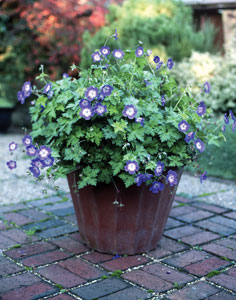
I hear the annual growers: Hey, I already grow geraniums! No, you don’t. You grow Pelargonium, the real name of all those ivy-leaf and zonal “geraniums” in your pot and basket programs.
If you can choose only one real Geranium, make it Rozanne. Discovered by an English gardener and launched by Blooms of Bressingham, Rozanne doesn’t seem to know it’s a perennial. She just flowers on and on, shrugging off dry summers, wet summers, and all kinds of winters with equal aplomb.
Advantages: A beautiful, versatile plant with terrific name recognition. A Perennial Plant of the Year winner.
Disadvantages: Patented, and grown almost exclusively from tissue culture. Starters are pricey.
HIBISCUS—Marsh mallow
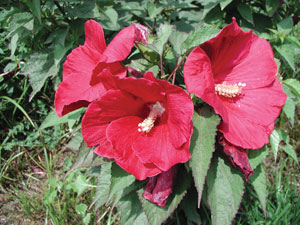 If you can grow the tropical kind, you can grow the hardy ones. The hang-up has long been that H. moscheutos goes winter-dormant and may not awaken until Memorial Day. Growers get around that in a couple of ways.
If you can grow the tropical kind, you can grow the hardy ones. The hang-up has long been that H. moscheutos goes winter-dormant and may not awaken until Memorial Day. Growers get around that in a couple of ways.
Ball’s Luna series are seed-propagated, finishing in just 13-14 weeks from sowing in summer, two weeks longer when sown in spring. Aris Horticulture sells its Vintage and Cordials series as “green and growing” liners propagated in Florida. Shipped March to June, they finish and flower fast enough to sell the same season.
Advantages: Huge, traffic-stopping, dinner-plate-sized flowers. Responsive to PGRs. Heat tolerant.
Drawbacks: Heavy feeders. Japanese beetle magnets. Can be tricky to ship.
LEWISIA—Bitterroot
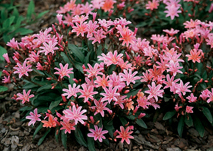 In flower, this cheerful little native is a showstopper. Cute, striped flowers rise on wiry stems over low clusters of semi-succulent foliage. The genus also has a great story: Named for Captain Meriwether Lewis, it was discovered by the Lewis and Clark expedition in the Bitterroot Mountains. Lewisia demands perfect drainage, unfortunately for gardeners in my area. To my chagrin, I’ve killed every one I ever attempted outdoors.
In flower, this cheerful little native is a showstopper. Cute, striped flowers rise on wiry stems over low clusters of semi-succulent foliage. The genus also has a great story: Named for Captain Meriwether Lewis, it was discovered by the Lewis and Clark expedition in the Bitterroot Mountains. Lewisia demands perfect drainage, unfortunately for gardeners in my area. To my chagrin, I’ve killed every one I ever attempted outdoors.
Seed of numerous species is available from Jelitto Perennial Seeds. L. xcotyledon and L. longipetala varieties are the showiest and most commonly grown.
Lewisia is happiest in a rock garden planted in scree with scant organic matter, but several plants outside the greenhouses here seem to have handled this winter just fine. I’ll observe them from a safe distance.
Advantages: Easy to grow in containers. Makes an irresistible windowsill pot. Native.
Drawbacks: Very cold tolerant, but difficult to overwinter where the ground stays wet; i.e., much of the U.S. Germination can be tricky and slow; Jelitto’s pretreated Gold Nugget seed helps, but isn’t available for all types.
SCABIOSA—Pincushion flower
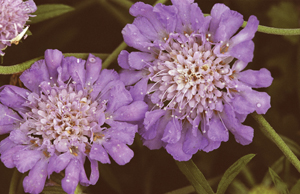 S. columbaria Butterfly Blue, bred by David Tristram, is an obvious choice. It flowers so incessantly, it sometimes exhausts itself to the point of being, effectively, an annual. Its patented sibling, Pink Mist, is equally floriferous. Both make good quart pots, with flowers reaching to about 18 in.
S. columbaria Butterfly Blue, bred by David Tristram, is an obvious choice. It flowers so incessantly, it sometimes exhausts itself to the point of being, effectively, an annual. Its patented sibling, Pink Mist, is equally floriferous. Both make good quart pots, with flowers reaching to about 18 in.
A promising seed-propagated variety from Kieft may make even better small pots: S. japonica v. alpina Blue Diamonds is considerably smaller at 8 in. to 10 in., and it flowers all summer.
Advantages: Constant color. Early tendency of Pink Mist to revert to blue has been corrected.
Drawbacks: Constant flowering can wear the plant out. In the garden, a fall cutback encourages new foliar growth and helps increase winter survival.
GRASSES
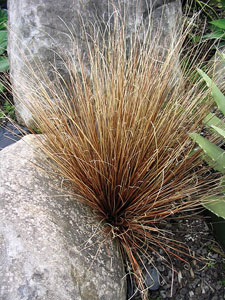 No longer a specialty crop for niche producers, ornamental grasses have true mainstream appeal. For small pot production, the go-to genus is Carex. The Color Grass selections by Kieft Pro-Seeds are well chosen for pots. Kieft trademarked some clever names for species grasses, a ploy that raises the hackles of nomenclature purists and other seed houses. But—surprise—consumers find it easier to pronounce and remember Bronco, Bronzita, and Amazon Mist than C. comans, C. flagellifera and C. buchananii, so for better or worse, the made-up names have stuck.
No longer a specialty crop for niche producers, ornamental grasses have true mainstream appeal. For small pot production, the go-to genus is Carex. The Color Grass selections by Kieft Pro-Seeds are well chosen for pots. Kieft trademarked some clever names for species grasses, a ploy that raises the hackles of nomenclature purists and other seed houses. But—surprise—consumers find it easier to pronounce and remember Bronco, Bronzita, and Amazon Mist than C. comans, C. flagellifera and C. buchananii, so for better or worse, the made-up names have stuck.
The Color Grass lineup includes six varieties of carex and one or two each of six other genera including Corynephorus, Luzula and Uncinia. You can grow the same plants by their real names, of course, but ... see above.
Advantages: Grasses are easy and resilient, and don’t have to be huge. Small types make good filler in combo pots.
Drawbacks: “Is that all it does?” Um, yes.
Many other perennial genera can play annual roles; fragaria, lamium, salvia, and heuchera are just a few examples. The indestructible succulents—sedum and sempervivum are waiting to be discovered.
Other ornamental grasses worthy of note are
Pennisetum xadvena Rubrum and its sport, Fireworks. But while technically perennials, they’re not hardy north of Zone 9. Which makes them annuals for perennial growers, and that’s another story.
GT
John Friel is marketing manager for Emerald Coast Growers and a freelance writer.